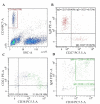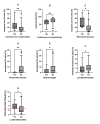Association Between Cytometric Biomarkers, Clinical Phenotype, and Complications of Common Variable Immunodeficiency
- PMID: 38406025
- PMCID: PMC10894026
- DOI: 10.7759/cureus.52941
Association Between Cytometric Biomarkers, Clinical Phenotype, and Complications of Common Variable Immunodeficiency
Abstract
Background: Common variable immunodeficiency (CVID) is a heterogeneous group of immune disorders. The patients are classified according to the clinical manifestation with the infection-only phenotype (CVIDinf) and CVID with immune dysregulation (CVIDid).
Methods: We performed a retrospective clinical analysis of 64 CVID patients (34 males, 53.13%; mean age: 41.4 years; SD: ±21.4 years). We divided the patients into subgroups according to the clinical manifestation (CVIDinf and CVIDid) and according to B cell phenotypic profiling after performing flow cytometry with the use of the EUROclass classification. We compared clinical manifestations, selected laboratory parameters, and therapy in these groups. All CVIDid patients were tested after the manifestation of complications associated with immune dysregulation and in eight patients during the immunosuppressive treatment (systemic corticosteroids and hydroxychloroquine).
Results: Two-thirds of patients in our cohort had symptoms resulting from immune dysregulation. Almost half of the patients had autoimmune complications. A higher proportion of marginal zone B cells was associated with autoimmune complications. A lower percentage of naïve B cells was connected to autoimmunity, whereas a lower proportion of transitional B cells was associated with rheumatic diseases and splenomegaly. Patients with lymphadenopathy had a higher percentage of double-negative T cells and a lower percentage of switched memory B cells. We performed molecular-genetic testing in 28% (n = 17) of patients and found a causal pathogenic variant in 23.5% (n = 4) of this group.
Conclusion: Based on our results, there is an association between specific cytometric parameters, clinical phenotype, and complications of CVID. The use of the subpopulations of B cells can be helpful in the diagnosis of these specific clinical complications in CVID patients and could help to personalise the therapeutic approach.
Keywords: b cell phenotypic profiling; common variable immunodeficiency; immune dysregulation; marginal zone b cells; transitional b cells.
Copyright © 2024, Markocsy et al.
Conflict of interest statement
The authors have declared that no competing interests exist.
Figures






References
-
- The European Society for Immunodeficiencies (ESID) Registry working definitions for the clinical diagnosis of inborn errors of immunity. Seidel MG, Kindle G, Gathmann B, et al. J Allergy Clin Immunol Pract. 2019;7:1763–1770. - PubMed
-
- Comparison of various classifications for patients with common variable immunodeficiency (CVID) using measurement of B-cell subsets. Yazdani R, Seify R, Ganjalikhani-Hakemi M, et al. Allergol Immunopathol (Madr) 2017;45:183–192. - PubMed
-
- A theory of self-nonself discrimination. Bretscher P, Cohn M. Science. 1970;169:1042–1049. - PubMed
-
- T cell independent antigens. Mond JJ, Vos Q, Lees A, Snapper CM. Curr Opin Immunol. 1995;7:349–354. - PubMed
LinkOut - more resources
Full Text Sources
